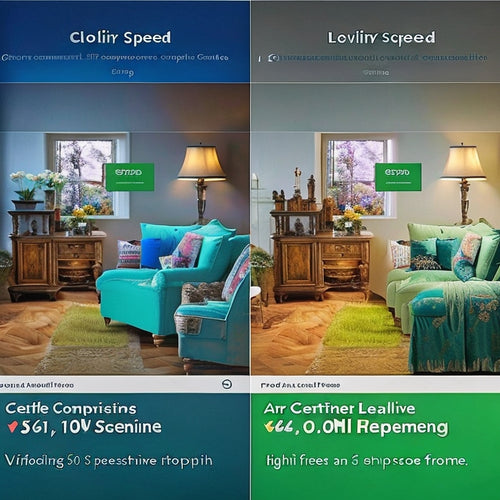
Maximize Online Course ROI With These 7 Strategies
Share
You can boost your online course's return on investment (ROI) by implementing seven key strategies. Start by optimizing your course content to align with learning objectives and engaging your students through quizzes, discussions, and multimedia. Next, set clear goals and metrics to track performance data and make data-driven decisions. Leverage email marketing automation and paid advertising to reach potential students and drive conversions. Improve user engagement with virtual events and immersive experiences. Enhance student support systems and landing page optimization to increase conversion rates. Finally, track and analyze performance data to refine your approach and maximize ROI. By following these strategies, you'll be able to reveal even more opportunities to grow your online course's success.
Key Takeaways
• Craft online course content aligned with learning objectives to boost engagement and retention, leading to higher ROI.
• Implement engagement strategies like quizzes, discussion forums, and multimedia content to capture and hold students' attention.
• Set clear goals, metrics, and tracking performance data to make data-driven decisions and identify areas for improvement.
• Leverage email marketing automation and paid advertising to increase course visibility, drive conversions, and maximize ROI.
• Optimize landing pages for conversions, align messaging with ad copy, and enhance support systems to reduce bounce rates and enhance targeting strategies.
Optimize Course Content for Results
By carefully crafting your online course content to align with specific learning objectives, you can greatly enhance student engagement, retention, and overall performance. This is where content optimization comes into play. It's about creating a strategic plan to make certain your content resonates with your target audience, drives meaningful interactions, and achieves the desired outcomes.
To optimize your course content, you need to identify the most effective engagement strategies for your students. This might involve incorporating interactive elements, such as quizzes, gamification, or discussion forums, to encourage active participation and foster a sense of community.
Additionally, consider using multimedia content, like videos or podcasts, to cater to different learning styles and preferences. By doing so, you'll be able to capture and hold students' attention, increase their motivation, and ultimately, boost their learning outcomes.
Set Clear Goals and Metrics
When creating an online course, you need to know what you're working towards. That's why defining key objectives that align with your desired outcomes is crucial.
Define Key Objectives
You'll need to pinpoint specific, measurable outcomes for your online course, so define key objectives that align with your business goals and identify the metrics that will gauge their success. This is important because it will guide your course creation and marketing efforts.
To define key objectives, ask yourself:
-
Who's your target audience, and what're their pain points that your course will address?
-
What're the learning outcomes that students will achieve by taking your course, and how will you measure their progress?
-
How will you improve retention and engagement throughout the course to make sure students complete it and achieve their desired outcomes?
Track Progress Metrics
Two essential metrics to track for maximizing ROI are student engagement and course completion rates, which will give you a clear picture of how well your online course is performing.
By tracking these metrics, you'll be able to identify areas that need improvement and make data-driven decisions to optimize your course.
To take it to the next level, use data visualization tools to turn your metrics into actionable insights. This will help you quickly identify trends and patterns, and make adjustments to your course content, marketing strategy, or student support systems.
Regular performance tracking will also enable you to measure the effectiveness of your course updates and adjustments.
By monitoring your metrics regularly, you'll be able to see what's working and what's not, and make adjustments accordingly.
This continuous cycle of tracking, analysis, and improvement will help you refine your online course and maximize your ROI.
Leverage Email Marketing Automation
Now that you've set clear goals and metrics, it's time to supercharge your email marketing efforts with automation. By leveraging email marketing automation, you'll be able to create targeted campaigns that resonate with your audience, which is essential for maximizing your online course ROI.
To get started, you'll want to focus on three key areas: running targeted campaigns ahead of time, automating segmented lists, and personalizing every touchpoint.
Targeted Campaigns Ahead
By leveraging email marketing automation, targeted campaigns can be tailored to resonate with specific segments of your audience, greatly boosting engagement and conversion rates. This allows you to focus on the most profitable areas of your online course business, maximizing your ROI.
With automation, you can:
-
Nurture leads through a series of targeted emails, guiding them from awareness to enrollment
-
Retarget cart abandoners with personalized messages, encouraging them to complete their purchase
-
Upsell and cross-sell to existing students, offering relevant additional courses or resources
Automate Segmented Lists
You can take your targeted campaigns to the next level by automating segmented lists, which enables you to categorize your audience based on their behaviors, preferences, and demographics, and then tailor your messaging to resonate with each group.
By leveraging email segmentation, you can create customized course recommendations that cater to individual interests and needs. For instance, you can create separate lists for students who've completed a particular course, or those who've shown interest in a specific topic. This allows you to send targeted promotional emails that are more likely to convert.
Automated reminders are also a powerful tool in your email marketing arsenal. By setting up automated reminders, you can make sure that students receive timely notifications about upcoming deadlines, new course releases, or special promotions.
Additionally, you can use automation to deliver personalized content that speaks directly to each student's goals and aspirations. By automating segmented lists, you can save time, increase engagement, and ultimately drive more sales for your online courses.
Personalize Every Touchpoint
Every interaction with your online course brand is an opportunity to build trust and loyalty. Leveraging email marketing automation allows you to personalize every touchpoint, from welcome emails to abandoned cart reminders, to create a seamless and engaging student experience.
By tailoring your communication to individual students, you can create a sense of belonging and connection. This can be achieved through customized communication that addresses students by name, acknowledges their progress, and offers relevant resources.
Here are a few ways to get started:
- Use student data to trigger targeted email campaigns that speak directly to their needs and interests
- Create personalized content recommendations based on course progress and engagement metrics
- Send automated reminders and notifications that are tailored to individual student milestones and deadlines
Improve User Engagement Strategies
To boost the effectiveness of your online course, it's essential that learners stay invested in the material, which is where well-crafted engagement strategies come into play. You need to create an immersive experience that encourages learners to participate, share, and connect with the content and each other.
One way to do this is by incorporating interactive activities that challenge learners and stimulate their curiosity. Discussion forums are another excellent way to facilitate collaboration and foster a sense of community. By creating a space for learners to ask questions, share insights, and learn from each other, you can increase their engagement and motivation.
To take engagement to the next level, consider incorporating gamification elements, such as rewards, badges, or leaderboards, that tap into learners' competitive spirit. Virtual events, like webinars or live sessions, can also help create a sense of excitement and urgency, making learners feel more connected to the course and its objectives.
Utilize Paid Advertising Effectively
Your online course's success hinges on its visibility, and strategically leveraging paid advertising can propel it to the forefront of your target audience's attention. By allocating a budget for targeted ads, you can reach potential students who are actively seeking solutions like yours.
To maximize your ROI, focus on crafting compelling ad copywriting that resonates with your audience and drives conversions.
Here are a few key strategies to keep in mind:
-
Targeted demographics: Use social media platforms and Google Ads to target specific age ranges, interests, and behaviors that align with your ideal student.
-
A/B testing: Continuously test and refine your ad creative, headlines, and copy to optimize performance and reduce waste.
-
Landing page optimization: Secure that your landing page is optimized for conversions, with clear and concise messaging that aligns with your ad copy.
Enhance Student Support Systems
How can you ensure that students who enroll in your online course receive the support they need to succeed, thereby reducing frustration and increasing the likelihood of completion and positive word-of-mouth?
By implementing a robust support system, you can guarantee that students feel seen, heard, and empowered to achieve their goals. This starts with 24/7 availability, where students can access help whenever they need it. This can be achieved through AI-powered chatbots, email support, or even phone support.
Additionally, consider fostering peer collaboration through online communities, discussion forums, or social media groups. This allows students to connect with one another, share experiences, and learn from each other's perspectives. By doing so, you'll create a sense of belonging and accountability, which can significantly boost student engagement and motivation.
Furthermore, make sure to provide clear, concise, and easy-to-follow instructions, along with regular check-ins and progress tracking. By putting the right support systems in place, you'll set your students up for success, leading to higher course completion rates and glowing testimonials.
Track and Analyze Performance Data
By monitoring key performance indicators like course completion rates, student engagement metrics, and assessment results, you can identify areas of improvement and optimize your online course for maximum ROI. This data-driven approach allows you to make informed decisions, refine your strategy, and boost profitability.
To get the most out of your performance data, focus on the following key areas:
Completion rates: Analyze trends in course completion to identify bottlenecks and areas where students may be struggling.
Student engagement: Monitor results of student surveys, discussion forums, and other engagement metrics to understand what's working and what's not.
Assessment results: Track student performance on quizzes, exams, and other assessments to identify knowledge gaps and areas for improvement.
Frequently Asked Questions
How Long Does It Take to See Results From Online Course Optimization?
You'll start seeing results from online course optimization within a few weeks to a few months, depending on your tracking and measuring effectiveness, but you'll likely notice an immediate impact once you start tracking progress.
Can I Use Free Advertising Channels to Promote My Online Course?
"Break out your quill and parchment, modern marketer! You can harness free advertising channels to promote your online course. Leverage social media's vast reach and email marketing's targeted precision to spread the word, sans budget."
What Is the Ideal Length for an Online Course to Maximize Engagement?
You'll maximize engagement by structuring your course into bite-sized modules, ideally 20-40 minutes long, to cater to learners' dwindling attention span, and track engagement metrics to boost retention and overall course effectiveness.
How Often Should I Update My Online Course Content to Stay Relevant?
You should update your online course content every 3-6 months to maintain relevance, ensuring a content refresh frequency that keeps students engaged and knowledgeable about the latest developments in the field.
Are Online Courses More Profitable Than Traditional In-Person Teaching?
You're like a chef choosing between a sizzling online kitchen and a traditional brick-and-mortar restaurant. Online courses are often more profitable due to lower costs and higher market demand, allowing you to scale revenue without scaling expenses.
Related Posts
-
Unlocking The Power Of Shoppable Videos: A Guide To Engaging And Converting Viewers
Shoppable videos have revolutionized the way viewers interact with content, offering a seamless shopping experience a...
-

How Do I Optimize My Shopify Speed Score
This article aims to provide guidance on optimizing the speed score of a Shopify website. The optimization of Shopif...
-

Does Shopify Offer SEO Optimization
This article examines the question of whether Shopify offers SEO optimization. It aims to provide an objective and i...

